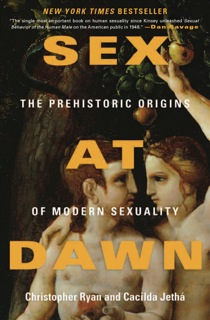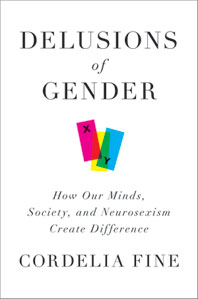Can I have my monogamy and happiness too?
Posted in Book Reviews on January 10th, 2011by Elizabeth
Tags: Science • Sex
Sex at Dawn
The Prehistoric Origins of Modern Sexuality
by Christopher Ryan and Cacilda Jetha
I’ve been reading Dan Savage’s love and sex advice column for eleven years, since I was seventeen. At first I was shocked and titillated by the openness of his writing about sex. I had halfway decent sex education at home and in high school. But nothing my teenage classmates put into our Health teacher’s question box was like the letters printed in “Savage Love.” As I got older I came to appreciate Dan Savage on a different level. There are lots of websites with basic information about sex, but there’s something about a personal, yet public response from a knowledgeable person who will occasionally make fun of you that drives thousands of people to ask his advice every week.
I’d noticed that in the past 2 or 3 years Dan had started to question the premise of monogamy. He would often point out to a person grieving their partner’s infidelity, that so many people are bad at staying faithful and ask if a partner has extra marital sex once or twice in their entire life, is that really worth a messy breakup or divorce? In his book “Skipping Towards Gomorrah” Savage presents a picture of American swingers as very happy people with stable relationships. He often writes about this alternative in his column.
As some of you may know, I have recently gotten married, so monogamy has been at the forefront of my mind for most of the recent past. I freely admit to having a happy and healthy newlywed glow. Any criticism I have of “Sex at Dawn,” I have thought seriously about – I don’t want to fall into the trap of letting my current status poison my analysis. But in case I have failed, let the record show that I have admitted my bias freely.
Before deciding to marry I did think seriously about the concept of monogamy; if it were possible and if my partner and I were capable of it. Being young and in love, and at the beginning of a marriage is the wrong place to ask those questions however. It would be like asking all of the runners of a race at the starting line if they will finish. Surely some will sprain ankles or give up. But who would admit the possibility of failure when filled with the adrenaline and optimism of race day? Dan Savage’s advice to his readers gave me hope – he seemed to be saying that some people are just not cut out for monogamy. Just like some people are gay, or straight, or bisexual. If that was true, then I was good to go – monogamy feels as natural to me as my heterosexuality.
Then Dan Savage started raving about “Sex at Dawn.” I rolled my eyes. I have a really bad habit of lurking on MRA/PUA blogs until my mood is absolutely spoiled. Now I’m going to have to hear about how I’m made for hypergamy, incapable of love and should be dehumanized from Dan Savage too?!
I read the Salon review of the book, which piqued my interest.
I listened to the Savage Lovecast where Ryan said “It’s not that women are whores. It’s that they’re sluts.” And that’s when I knew I had to read the book. I had often wondered if there was an argument to be made about why and how so many cultures spend so much effort repressing female sexual desire if it did not exist, but did not know where to look. Sex at Dawn sounded like it would explore this question.
The thesis of the book is that human beings evolved in groups where men and women both had multiple sexual partners. Monogamy only came about when people adapted to agriculture. The evidence is vast, ranging from the behaviors of our chimp and bonobo cousins to specific features of the human reproductive system (Mark Twain said it best when he remarked that women should probably have harems and not men, since men could only satisfy one partner per night). What I found most convincing was the evidence that early hunter-gatherer tribes probably shared food and other resources equitably. There are different groups of people all over the world who most likely still live in the way that our early ancestors did. In those societies, some of whom have never had contact with the others, hoarding food or refusing to share is the greatest taboo. Things started to click in my mind before it was spelled out in the book. If a man must share the meat from his hunt with all of the children in the tribe, how could he possibly favor the ones that are biologically his? What purpose would it make to try and assure paternity if that knowledge could not be used? If our concept of possession and property did not extend to the very food we labored to acquire, how could we have been jealously guarding pair bonds of one man and one woman? The theory that humans were not monogamous for the vast majority of our history was becoming more difficult for me to simply dismiss.
Christopher Ryan has been careful to say that just because people did not evolve to form monogamous pairs doesn’t mean that they should not attempt it. He has famously compared it to being vegan – a worthy goal fraught with difficulty and lots of temptation.
The authors do come dangerously close to committing the fallacy that they so artfully dismantle. There is frequent reference to the “standard narrative” which both resembles the idealized version of 1950’s sexuality and the bleak perspective of those who insist that men and women must always be at war with one another because they have diametrically opposed reproductive strategies. They make the argument that women’s sex drives are powerful and capable of a lot more than any Western societies have been willing to admit. The authors dare to ask the question – if women are so naturally reserved, why are so many restrictions required of women? Would a truly asexual gender need them?
And yet their chapter about modern day marital infidelity only includes one case study of a man cheating on his wife. I will say that they did a very good job of skillfully and sensitively presenting the evidence of why a man with so much to lose would do such a thing, and making it clear that they do not mean to rub salt in the wounds of the wives who are so hurt. But there is no corresponding narrative of why a woman would cheat or why her husband should make an effort to understand her natural drives and hormonal confusion. Simply presenting evidence that men who have more partners have higher testosterone levels, and that low testosterone can lead to all sorts of issues up to an including death is sobering. But it doesn’t fiat away the fact that this does lend strength to the “standard narrative” that they are so opposed to. Instead of falling back on “Sorry honey, my sperm is cheap, her eggs are expensive and my secretary is young and fertile,” will it now become “Sorry honey my Testosterone was getting low so it was pretty much sex or death?”
I do love the fact that Sex at Dawn does acknowledge how complicated the human brain is. It has always frustrated me that so little popular Evolutionary Psychology narratives seem to address the higher brain functions performed by the neocortex. Human beings have a lot more grey matter than just our reptile brains. If we could master our environment enough to put a man on the moon couldn’t we also create an equally sophisticated view of gender roles? I had been taught that our large brains evolved because the ability to use language, solve problems systematically and build tools were tremendous advantages. Ryan and Jetha speculate that the neocortex evolved because of the complicated webs of human relationships that a large brain was required.
Another thing I appreciate about Sex at Dawn is the understanding the authors have of the context in which they are writing it. Christopher Ryan’s blog posts appear to acknowledge that many evolutionary psychology studies are used to uphold the status quo, justify sexism or just plain right wing politics (and he is unabashedly liberal.) I don’t think that scientists should self censor for fear of a particular political climate or backlash. But the way they present their work should be informed by an understanding of its consequences.
Dan Savage’s quote on the front cover of the book calls it, “The single most important book on human sexuality since Kinsey unleashed Sexual Behavior of the Human Male on the American Public in 1948.” Christopher Ryan has balked at this, and his modesty is very becoming. I’m not an expert on human sexuality so I can’t speak to the veracity of the claim, but it did make me more interested in evolutionary psychology than I had previously been.
Ryan and Jetha criticize people who encourage married couples to get divorced simply because of infidelity, citing studies that children are better off when their parents are married and suggesting that many of those couples would be happier trying to work past it or changing their arrangement to allow sex with other people. It has become fashionable to say that people shouldn’t make promises that they cannot keep. It’s usually my response to celebrity infidelity scandals. However there are huge pressures to marry and it’s not wise to ignore those pressures when doling out advice.
If I could ask one question of the authors, it would be this: Is there any research on what characteristics or behaviors of people who are “good at monogamy” have in common? It might seem like wishful thinking. But I have applied social science research to my personal life before. When I was in graduate school, I was living away from my husband. I read this book by a psychologist who interviewed people in long distance relationships and reported on the behaviors and circumstances that the couples who stayed together and were the happiest had in common. The book was a great source of comfort to me and we did apply some of the suggestions to our relationship.
Another acquaintance of mine set her mind on a goal of losing weight – something 95% of the people who do fail. And yet Greta has been successful. She started by researching extensively the habits and methods of people who have done it before.
I know that Ryan and Jetha wanted their book to spark debate and conversations, but ones more along the lines of “knowing what we now know about human sexuality, how should we apply this to our relationships?” I think that’s an important discussion to have as well. I have no objection to polyamory for those who wish to partake in it. But just as they have convincingly rejected the “standard narrative” of human sexuality I’m not as eager to jump on the bandwagon of another. I reject the premise that failure is inevitable. If, as they report in the book, 38% of couples report being happily married – even if half of them are lying – the odds of being happily monogamous are still more than three times better than the odds of successfully losing weight. The message that love is possible without monogamy is a vital one that needs to be repeated. But I admit to wanting both.



